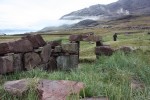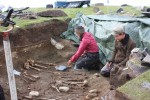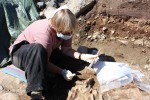 Vikings from Norway, Iceland and Denmark began to colonize Greenland in the late 10th century. Those were the halcyon days of the Medieval Warm Period (950 to 1250 A.D.), when pastures were green and farmland fertile. The Norse brought cattle with them and started farms in hundreds of settlements on the southern fjords. They prospered at first, founding vibrant communities with dozens of churches.
Vikings from Norway, Iceland and Denmark began to colonize Greenland in the late 10th century. Those were the halcyon days of the Medieval Warm Period (950 to 1250 A.D.), when pastures were green and farmland fertile. The Norse brought cattle with them and started farms in hundreds of settlements on the southern fjords. They prospered at first, founding vibrant communities with dozens of churches.
The good times started cooling off in the 13th century as the fertile warmth was replaced by the frigid storms of the Little Ice Age. For years historians have thought that the colder temperatures had resulted in crop failure and the death of livestock which in turn decimated the Norse colony. Settlers died from famine and disease and whoever was left beat a hasty retreat.
An archaeological study by a team of Danish and Canadian researchers proffers a new reason for the demise of the Norse settlements in Greenland: they chose to leave in orderly fashion in order to sustain their cultural identity and live in the style to which they did not want to become unaccustomed. The bone evidence and material remains suggest that the Viking settlers were not starving or ill, that they left the island deliberately taking all their valuables with them. It wasn’t a matter of life or death. It was a matter of the life they wanted to live no longer being possible.
 The Norse settlers had lived for two centuries eating primarily food they cultivated and beef they raised, only supplementing their diet with seafood. Their aim in moving to Greenland was to get some land of their own to farm and ranch. Building materials, wood, iron, were supplied by trade with their homelands. The plan worked as long as the warm period held.
The Norse settlers had lived for two centuries eating primarily food they cultivated and beef they raised, only supplementing their diet with seafood. Their aim in moving to Greenland was to get some land of their own to farm and ranch. Building materials, wood, iron, were supplied by trade with their homelands. The plan worked as long as the warm period held.
With the onset of colder temperatures, the pastures couldn’t support the cattle over the long winters. For a few decades ranchers tried replacing the cattle with pigs, but by 1300 the pigs were gone too. Sheep and goats lasted longer, but ranching and farming as the Norse practiced them simply could not sustain life in the new climate. There is no evidence that they even tried to keep the cattle alive using a starvation diet, a practice that was thoroughly established by their ancestors in cold climes and remained in use until recently.
 Seafood, which had supplied no more than 30% of their diet in the warm days, shot up to 80% in the 14th century. Most of that 80% was seal, a reliable supply of which could be secured during the animals’ yearly migration stops on the island. They also had to use seals and fish to feed whatever livestock they had left.
Seafood, which had supplied no more than 30% of their diet in the warm days, shot up to 80% in the 14th century. Most of that 80% was seal, a reliable supply of which could be secured during the animals’ yearly migration stops on the island. They also had to use seals and fish to feed whatever livestock they had left.
Trade shriveled up too. The market for walrus tusks and seal skins, the goods the Greenland colonists had to trade, bottomed out. Ships came less frequently until by the middle of the 14th century there was no regular trade between the Norse settlements of Greenland and the motherlands of Norway and Iceland. Without reliable trade they had to hope for a random ship to stop by to renew their supply of iron or wood.
To paraphrase T.S. Eliot, that was not what they meant at all. That was not it, at all.
The settlers were probably also worried about the increasing loss of their Scandinavian identity. They saw themselves as farmers and ranchers rather than fishermen and hunters. Their social status depended on the land and livestock they owned, but it was precisely these things that could no longer help them produce what they needed to survive.
Although the descendants of the Vikings had adjusted to life in the north, there were limits to their assimilation. “They would have had to live more and more like the Inuit, distancing themselves from their cultural roots,” says [National Museum of Denmark archaeologist Jette] Arneborg. “This growing contradiction between identity and reality was apparently what led to their decline.”
 The young people of childbearing age left first. Archaeologists found almost no skeletons of young women from the late period of Norse settlement. The documentary evidence supports that pattern. The wedding of Thorstein Olafsson, a lad from Iceland, and Sigrid Björnsdottir, a local girl, was held on September 14th, 1408, in Greenland’s Hvalsey Church. We know this because when they moved to Iceland, they had to prove to the local bishop that they had been married in a proper sanctioned church ceremony. Those documents are the last records we have of the Norse settlers in Greenland.
The young people of childbearing age left first. Archaeologists found almost no skeletons of young women from the late period of Norse settlement. The documentary evidence supports that pattern. The wedding of Thorstein Olafsson, a lad from Iceland, and Sigrid Björnsdottir, a local girl, was held on September 14th, 1408, in Greenland’s Hvalsey Church. We know this because when they moved to Iceland, they had to prove to the local bishop that they had been married in a proper sanctioned church ceremony. Those documents are the last records we have of the Norse settlers in Greenland.
Everyone else left shortly thereafter. The fact that no precious objects have been unearthed anywhere in the archaeological record of Norse Greenland indicates that they moved, packing all their treasures, rather than being devastated by disease, natural disaster or starvation. The bone evidence confirms that there was no more illness and hunger among the late Nordic population of Greenland than among comparable populations in Scandinavia.